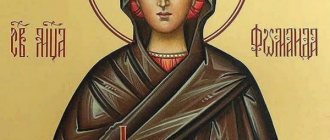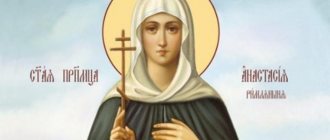Angel Anastasia Day - what date is this day celebrated? Nastya, Nastenka, Anastasia - this name is loved by many to this day, for how many years the name has not lost its relevance. What date is the day of the angel Anastasia according to the church calendar? History has known several Anastasias who are canonized by the church; the holiday is celebrated several times a year, but each person celebrates the holiday once, the one that is closest to the date of birth. Today we will talk about what date Anastasia’s Angel Day is. Read the next article on pages.
Meaning of the name
The name Anastasia came to Russian lands from Ancient Greece. Previously, both female and male versions of this name were used, but only the female name has stuck with us. In Ancient times, this name was used to mean “resurrection”, “return to life”.
Interesting to know! Over the past few decades, this name has repeatedly ranked number one on the list of most popular names. The name Anastasia is most often inferior to such female names as Maria, Anna and Sofia. 8 years ago, out of a hundred newborn Muscovites, 53 were called Nastenka.
Stronger than fear
All the prisons of Rome at that time were full of Christians. The prisoners were almost never visited - it was dangerous to sympathize in word, much less in deed. Many Christians rotted alive, dying from wounds without any anesthesia; others, without waiting for execution, died from illness and exhaustion.
Anastasia knows about this and finds a way to help. Dressed as a beggar woman and bribing the guards (there was money), she donates food, water, medicine, clothes to the prison, and she herself comes and bandages the wounds.
Such fearlessness of a very young girl, in the midst of universal horrors, for people one step away from death becomes evidence: yes, that strange love that Christ spoke about really exists. And she consoles, gives strength, and she herself is stronger than fear.
Patron Saints
When speaking about the patron saints of girls with this name, the first to be remembered is Anastasia the Pattern Maker. The Great Martyr suffered for her faith during the reign of Emperor Diocletian, when the persecution of Christians was especially cruel.
Saint Anastasia the Pattern Maker
The most sophisticated tortures were applied to them - people were burned at the stake, drowned in the sea, with a millstone tied to their necks, tortured and tormented. Anastasia was not afraid of threats, visited sufferers in prison, supported and consoled them. Soon she was also captured and sentenced to be burned at the stake. The Day of Remembrance of the Righteous Lady is January 4.
In Rome, another martyr named Anastasia suffered for her faith. Anastasia the Roman came from an ancient noble family. The girl was very beautiful, many noble young men of the city sought her hand, but she answered everyone with an invariable refusal. The girl was brought up in the Christian community of the city and wanted to devote her life to serving Christ.
One of the unlucky suitors betrayed Anastasia to the mayor, and he ordered the girl to renounce her faith and become the wife of one of the city patricians. After a negative answer, Anastasia was brutally tortured in front of the townspeople, and then beheaded. They remember the righteous woman on November 11th.
Another resident of Rome, Anastasia of Rome, was executed for participating in the burial of the bodies of Christians killed by order of Emperor Nero. Saint's Day of Remembrance - April 28.
Anastasia of Alexandria was the wife of a wealthy patrician. She was widowed at a young age and decided to devote her life to God. After some time, she learned that the emperor was looking for her. Having been widowed, he wanted to marry the woman he liked. Anastasia did not want to become the wife of a monarch, so she turned to Abba Daniel for help.
Saint Anastasia Patricia (hermit)
He dressed the woman in men's clothes and showed her the lonely cave in which Anastasia lived all her life. None of the monks went inside; they only left water and food on the threshold for the righteous woman. Anastasia's Memorial Day is March 10.
Legends and speculation shroud the life path of Anastasia Romanova. According to one of the most widespread legends, Anastasia was not harmed during the execution of the royal family, but was able to escape from Russia. The end to this story was put in 2011 after genetic examinations were carried out.
Venerable Anastasia Patricia
Saint Anastasia was the daughter of noble and wealthy parents from Constantinople. At one time she got married, but was widowed early and stayed at the royal court of Emperor Justinian. The patrician was God-fearing and led a pious life, keeping God's commandments. In addition to being beautiful, she was distinguished by her meekness, good disposition, and was an example of Christian virtue. She enjoyed the honor and respect of the king, but the enemy of the human race instilled hatred of her in the heart of Queen Theodora.
Guided by good thoughts, wanting to turn the queen away from the sin of hatred, leaving most of her gold, she sailed secretly to Alexandria. She founded a small monastery near the city, where she began to dwell in physical and mental labors. All her time was spent doing needlework while singing psalms, praising the Lord, trying to be pleasing to Him in everything. Several years of life devoted to serving God passed, Queen Theodora died, and the emperor decided to find the noble patrician. Having heard about this and not wanting to return to the court, the saint went to the skete to Saint Daniel, to whom she told about everything that had happened. The elder blessed her for further service, gave her a man's monastic robe and named her Anastasius the Eunuch. The place of retreat for the newly-minted eunuch was determined in a secluded cave, remote from the monastery. Having instructed Anastasia in the rules of life, he forbade her to go outside and not accept anyone.
Only one of the monks named Danila brought bread and water to the recluse once a week, leaving it at the entrance. The saint lived in that cave for twenty-eight years, living in the constant struggle of desert life. Not seeing anyone, and not being seen by anyone, she invariably fulfilled the rule prescribed by the elder. Her life consisted of a constant struggle with demonic temptations, which did not allow her to forget about her former life at court, full of sweet pleasures. But unceasing prayer, strict fasting, and all-night vigil helped to emerge victorious against the invisible enemy. There were tears, sobs and groans, but holy prayer and the Sign of the Cross were her joy and support. The hermit fought valiantly in an invisible battle, for which she gained God's mercy, becoming a vessel of the Holy Spirit. She knew about her impending death, writing a message to the elder on the shard and notifying him of this.
The elder came with a faithful monk, communed the Holy Mysteries and prepared the grave. The blessed one blessed the mentor and his companion and peacefully departed to the Lord. The student, dressing the deceased eunuch in a cassock, learned her secret. After the burial, the holy elder told his disciple everything about the life of Saint Anastasia.
V. Kharkhan
Days of remembrance of other God's saints named Anastasia
| Name Saint | Day of Remembrance |
| Anastasia Podvizhnitsa | December 26 |
| Reverend Anastasia | 4th of July |
| Martyr Anastasia | June 19 |
| Anastasia Lebedeva, Anastasia Kamaeva, Anastasia Titova | February 8 |
| Anastasia Latriyskaya | May 28 |
When choosing a name for their daughter, parents unwittingly choose a heavenly intercessor for the girl. A saint with this name will accompany the girl throughout her entire life, but the patronage of the righteous woman alone will not be enough. Parents themselves must take care of their daughter’s Christian upbringing, then her heart will be open to God’s mercy.
There is a rapist in the family
Illustration by N. Klimova from the site blogs.pravostok.ru
Soon, Pomplius’s husband found out where his wife went so often. He beat her and locked her in her chambers with guards. At this time, Anastasia's father dies and his entire fortune goes to her.
Pomplius begins to beat Anastasia regularly, hoping that she will die and the money will go to him.
The only consolation for Anastasia was a secret correspondence with her spiritual mentor Chrysogon, which she managed to continue with the help of devoted servants. In one of her letters, the saint wrote: “My husband... torments me as an opponent of his pagan faith in such a grave conclusion that I have no choice but to surrender my spirit to the Lord and fall dead.”
The teacher’s response words strengthened us in patience: “Light is always preceded by darkness, and after illness health often returns, and after death we are promised life.” Chrysogonus predicted that Anastasia would soon be freed from the power of her cruel husband. The prediction came true: Pomplius, as an ambassador, was sent to Persia, but the ship on which he sailed was caught in a storm and sank.
A friend in need is a friend indeed
Byzantine icon of Saint Anastasia from the early 15th century.
From the site diomedes2.livejournal.com For two months, the one who fed the hungry was not even given bread. God allowed this test so that more than a dozen martyrs could be comforted by friends.
At night, her friend, the holy martyr Theodotia, who was executed before her eyes, came to Anastasia and miraculously strengthened the saint. And Anastasia survived a two-month famine.
Then they tried to drown Anastasia, along with other convicts, on a ship whose bottom was broken when it was at a great distance from the shore. As soon as the ship began to sink, Saint Theodotia again appeared to the prisoners and helped the ship get to the pier. The 120 miraculously surviving convicts believed in the Christian God and immediately, on the rescued ship, were baptized by Anastasia.
All the newly baptized were soon executed and accepted death as martyrs. They tied the Great Martyr Anastasia to four pillars and lit a fire under her: but the flame did not touch her body, and her spirit ascended to God. The great martyr was buried by the Christian Apollinaria, and later built a temple over the place of her burial.
Christians pray to the Holy Great Martyr Anastasia in a variety of difficult circumstances, external or internal, asking for patience and understanding of the meaning of the suffering endured, for consolation and deliverance from them.
Shame of Ulpian
And soon they took Anastasia too. Emperor Diocletian, who was informed that a rich widow was spending her estate to help “despicable Christians,” was furious. He was especially outraged by the fact that she melted down household pagan idols made of precious metals for money and spent the money “on criminals.”
Considering Anastasia’s noble origins, the emperor left her the opportunity to save her life: the high priest Ulpian had to convince Anastasia to “come to her senses” and make a sacrifice to the pagan gods. Otherwise, torment and death awaited the saint.
Ulpian persuaded Anastasia, resorted to various tricks, but did not succeed. Then he became so furious that he wanted to finally violate Anastasia, who had kept her virginity, before handing her over for torture. But as soon as his hand touched the saint, the priest became blind. In horror, rushing to the pagan idols for help, he fell dead.
The Joy of Friendship
Holy Great Martyrs Anastasia and Vasilisa.
Photo from wikiwand.com Saint Anastasia had many friends who shared her life. One of them was the widow Theodotia. Friendship, united by the desire to help, without explaining to each other why, why take such risks and generally do all this, brought mutual consolation to their lives.
It was all the more painful to lose friends who died from torture and execution of their persecutors. Saint Anastasia more than once had to witness the torture and execution of dear people. I had to see the death of Theodotia and her three sons. Only faith in the meeting in Heaven strengthened me in those minutes.
Pattern Maker
Having become free, Anastasia immediately continued her work. A rich inheritance made it possible not to be limited in funds. Soon her teacher Chrysogonus was sent to trial presided over by Diocletian himself. The saint followed her mentor. Saint Chrysogonus was martyred.
And after a month he appeared to Anastasia in a vision and said that three young Christian women - Agapia, Chionia and Irina - would soon die as martyrs, and Anastasia must strengthen them before execution. Anastasia found future martyrs in prison and strengthened their faith as best she could. The girls were killed before her eyes, Anastasia herself buried them.
Now Anastasia began to visit not only the prisons of Rome, but also other places. During her lifetime, the Lord gave her the gift of healing and consolation, and even the hopelessly ill recovered, and the despondent were able to overcome mortal horror.
They began to call her the Pattern Maker: not only because she saved people from prison, but because she freed them from mental tightness and death, helped them see the meaning in their suffering and remain faithful to God.









